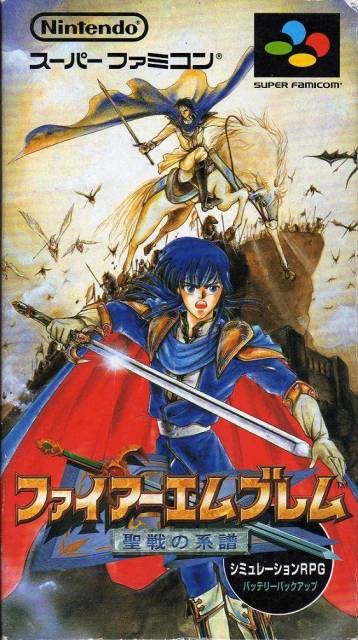A game of epic proportions, and a turning point in the series.
If you're a fan of strategy RPGs, this is one of the games your collection can't do without. The grand scale of things in this game is just breathtaking, whether it be the colossal maps (sometimes spanning an entire country) or the endless number of enemies you face.
Where to start, where to start. For the sake of the review, I'll start with gameplay. As I said before, the game is just epic. The maps you explore will always take up about 20 screens, with the exception of the prologue. In the second chapter (first if you don't count the prologue), you invade an entire country. Aside from the epic scale of the game, all the elements come together perfectly. You control a small army (which eventually grows to about 25 or so characters), saving villages, killing enemies and conquering castles in what would seem like a normal strategy RPG. However, if a character dies in battle, they remain dead, thus giving you more incentive to keep all your characters alive. Another nice feature is the love system. Letting two characters of opposite gender stand next to each other long enough will result in the two falling for each other. Besides stat boosts and almost automatic criticals, the characters in the first generation almost need to fall in love. Making sure who falls in love with who will seriously affect the second generation's stats, equipment and abilities, adding yet another layer of strategy to the tactic heavy game as it is. The game also enhances some of the frustrating parts of the earlier installments. Instead of limiting which characters can promote and having to spend extra time levelling up the character to get the most of them due to the 2 level tier system, you now have a one tier level system and you can level said character to the lowest level possible for promotion and still have a good chance of maxing them out. Weapons no longer break with no hope of ever using that particular sword again. Now it's possible to have your weapon repaired...for a fee of course. Plus you can't infinitely level up your character in the arena; now you have a limit of seven tough to face characters. However, arena abuse can still be managed through RNG abuse. Besides that, some elements of the game seem broken. For example, you can only let certain characters talk at certain points in certain chapters or miss it. Plus if you just happen to let an enemy get to your conquered castle, it's just destroyed with no hope of ever re-conquering it. Plus the game can be really short, especially for those who have already played games in the series. This is most noticeable at the beginning of the second generation, where all your characters have the potential to become powerhouses. You can blaze through chapters pretty quickly except when the AI corners you or you are one of those damn perfectionalists (like me) who insists on getting every character and item in the game. Despite it's shortcomings, it wraps up nicely into a great game that should last you at least 30 hours.
The graphics also got a nice overhaul compared to it's older brother, Monshou no Nazo. The overworld sprites (and the overworld) no longer look like the were easily done in a Paint program. They seem more like a painting rendered on the Genesis. The game's portraits have matured greatly. Whilst the last game had a children's Saturday morning cartoon feel, the portraits in Seisen no Keifu have a more seinen (teen anime) feel to them. The battle graphics, however, seem to be on even ground both in terms of artisticness and creativity. Whilst the overlapping features like forest edges are a nice little improvement, the graphics can't be compared because they both try to pull of different things. Whereas Monshou no Nazo had a realistic yet vibrant feel to the graphics, Seisen no Keifu seems to have a more cartoony look with realistic animations.
The sounds contribute greatly to the experience. Instead of hearing the same sound effect for each weapon, certain weapons are accompanied with different sounds. Whilst this is more prevalent in the spells than in the hand weapons, it's still nice to have that little feature. Whenever a character dies, a grunt (male) or a shriek (female) is followed after their death speech, something surprisingly absent in the American installments of the series. The music is also a vast improvement over the previous games in the series. Each score is much more involved and complex than the other installments. Whilst it predecessor merely had a hideously wretched melody repeating over and over, this game has a much more fitting theme that changes almost every chapter.
The story is very well written, but at some points it seems hard to follow. It also becomes hard to understand early on as it overindulges itself in politcal escapades that most people simply can't comprehend. The overload of events and mention of political terms you most likely will have to look up in a dictionary are a bit cumbersome. If you can manage to keep up with the events, there's a great story underneath the overload of events and mysterious words that plague the RPG genre.
If you're willing to put in the time to import the game and learn Japanese, by all means get it.
